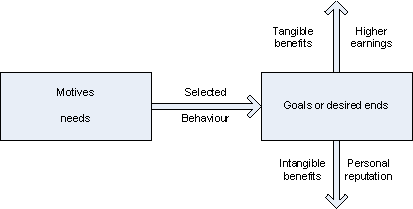Where Classical theorists were concerned with structure and mechanics of organisations, the theorists of human relations were, understandably, concerned with the human factors.
The foci of human relations theory is on motivation, group motivation and leadership.
At the centre of these foci are assumptions about relationship between employer and employee. Best summarised by Schein (1965) or Elton Mayo
The foci of human relations theory is on motivation, group motivation and leadership.
At the centre of these foci are assumptions about relationship between employer and employee. Best summarised by Schein (1965) or Elton Mayo
- they were academic, social scientists
- their emphasis was on human behaviour within organisations
- they stated that people's needs are decisive factors in achieving an organisation's effectiveness
- they were descriptive and attempted to be predictive of behaviour in organisations
A 'motive' = a need or driving force within a person.
The process of motivation involves choosing between alternative forms of action in order to achieve some desired end or goal
The process of motivation involves choosing between alternative forms of action in order to achieve some desired end or goal

Alternative forms of action of motivation depend on a manager's assumptions about his/her subordinates:
| Prime Motivators | Theory | |
| 1. Rational- economic man | Self interest and maximisation of gain | Basis of Classical, especially, Taylor/Scientific theory |
| 2. Social man | Social need, being part of a group | Basis of Mayo |
| 3. Self actualising man | Self-fulfilment of individual | Maslow, Likert, McGregor, Argyris, Herzberg |
| 4. Complex man | Depends on individual, group, task | 'Systems approach' |
Elton Mayo : Hawthorne Studies
The ground-breaking Hawthorne studies carried out in the Hawthorne plant of the Western Electric Company (USA) 1927 - 32.
Stage 1 (1924 -27)
Study of the physical surroundings (lighting level) on productivity of workers. Control group and experimental group previously had similar productivity before study began
Control Group = constant lighting level
Experimental Group = varied lighting level
Result
Both groups productivity increased - even when experimental group was working in dim light
Product leader called Mayo and colleagues to explain
Stage 2 (1927 - 29) 'Relay assembly room stage'
Still analysing effect of physical surroundings (rest, pauses, lunch break duration, length of working week) on output
Result
Output increased even when worsening conditions
Hypothesis was now that it was the attitudes of subjects at work and not the physical conditions. This gave rise to the 'Hawthorne Effect' - employees were responding not so much to changes in the environment as to the fact they were the centre of attention - a special group.
Stage 3 (1928 - 30)
A Total of 20,000 interviews were collected with the workers on employee attitudes to working conditions, their supervision and their jobs.
Stage 4 (1932) 'Bank winning observation room'
This time the new subjects (14 men) put in separate room for six months
Result
Productivity restricted due to pressure from peers to adopt a slower rate to circumvent company wages incentive scheme to generally adopt own group rules and behaviour
Advantages
- first real attempt to undertake genuine social research in industrial setting
- individuals cannot be treated in isolation, but function with group members
- that individual motivation did not primarily lie in monetary or physical condition, but in need and status in a group
- the strength of informal (as opposed to formal) groups demonstrated a behaviour of workers (formal supervisors were powerless in Stage 4)
- it highlighted need for supervisors to be sensitive and cater for social needs of workers within the group
Disadvantages
- from 1930s -1950s some doubt was cast on the increased applicability of these theories to every day working life
No comments:
Post a Comment